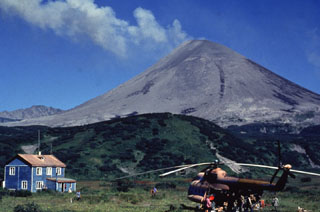Report on Karymsky (Russia) — July 2003
Bulletin of the Global Volcanism Network, vol. 28, no. 7 (July 2003)
Managing Editor: Edward Venzke.
Karymsky (Russia) May-July ash plumes; affiliated seismicity and satellite thermal anomalies
Please cite this report as:
Global Volcanism Program, 2003. Report on Karymsky (Russia) (Venzke, E., ed.). Bulletin of the Global Volcanism Network, 28:7. Smithsonian Institution. https://doi.org/10.5479/si.GVP.BGVN200307-300130
Karymsky
Russia
54.049°N, 159.443°E; summit elev. 1513 m
All times are local (unless otherwise noted)
Dark ash was observed on the NE, SE, and W flanks of the volcano on 30 May in a MODIS (moderate resolution imaging spectroradiometer) Terra image. Intermittent explosive eruptive activity at Karymsky occurred from early June into mid-August 2003, with seismic activity above background levels. Between 90 and 270 local shallow events occurred per day. The character of the seismicity indicated that ash-and-gas explosions to heights of 1,000-2,000 m above the volcano (2,500-3,500 m altitude) and gas blow-outs possibly occurred. On the morning of 17 July a strong, long duration (86 minutes), seismic event occurred that possibly resulted from a large pyroclastic flow or the onset of a new lava emission. Satellite data confirmed the continuing activity (table 3).
Table 3. Thermal anomalies at Karymsky from AVHHR (advanced very-high resolution radiometer) satellite images and visual observation during June and July 2003. Courtesy Kamchatka Volcanic Eruptions Response Team (KVERT).
| Date(s) | Thermal Anomaly (pixels) | Comments |
| 03 Jun 2003 | 2 (faint) | No ash plume observed |
| 22-24 Jun 2003 | 1-4 | -- |
| 27 Jun 2003 | -- | Short narrow plume to NE |
| 28-30 Jun 2003 | 1-4 | -- |
| 04, 06-09 Jul 2003 | 1-4 | -- |
| 14-15 Jul 2003 | 2-3 | -- |
| 13, 16 Jul 2003 | 2-5 | No ash plumes observed |
| 19 Jul 2003 | -- | Ash plume to SW |
| 25, 27-29 Jul 2003 | 1-3 | -- |
Geological Summary. Karymsky, the most active volcano of Kamchatka's eastern volcanic zone, is a symmetrical stratovolcano constructed within a 5-km-wide caldera that formed during the early Holocene. The caldera cuts the south side of the Pleistocene Dvor volcano and is located outside the north margin of the large mid-Pleistocene Polovinka caldera, which contains the smaller Akademia Nauk and Odnoboky calderas. Most seismicity preceding Karymsky eruptions originated beneath Akademia Nauk caldera, located immediately south. The caldera enclosing Karymsky formed about 7600-7700 radiocarbon years ago; construction of the stratovolcano began about 2000 years later. The latest eruptive period began about 500 years ago, following a 2300-year quiescence. Much of the cone is mantled by lava flows less than 200 years old. Historical eruptions have been vulcanian or vulcanian-strombolian with moderate explosive activity and occasional lava flows from the summit crater.
Information Contacts: Olga Girina, Kamchatka Volcanic Eruptions Response Team (KVERT), a cooperative program of the Institute of Volcanic Geology and Geochemistry, Far East Division, Russian Academy of Sciences, Piip Ave. 9, Petropavlovsk-Kamchatsky, 683006, Russia, the Kamchatka Experimental and Methodical Seismological Department (KEMSD), GS RAS (Russia), and the Alaska Volcano Observatory (USA); Alaska Volcano Observatory (AVO), a cooperative program of the U.S. Geological Survey, 4200 University Drive, Anchorage, AK 99508-4667, USA (URL: http://www.avo.alaska.edu/), the Geophysical Institute, University of Alaska, PO Box 757320, Fairbanks, AK 99775-7320, USA, and the Alaska Division of Geological and Geophysical Surveys, 794 University Ave., Suite 200, Fairbanks, AK 99709, USA.

